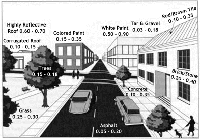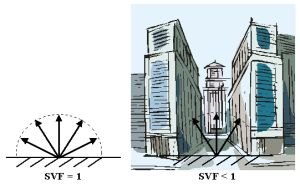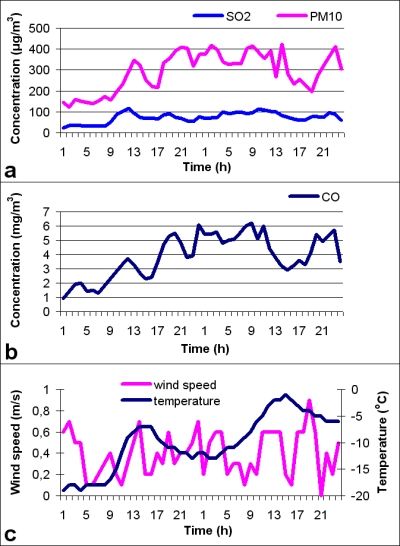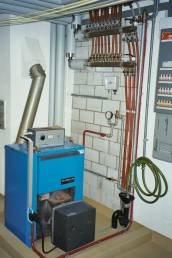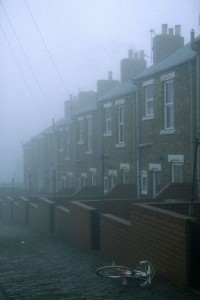 > ENC Master > Climate Encyclopaedia > Climate in Cities > basics > 2. Urban Climate > - What controls it?
> ENC Master > Climate Encyclopaedia > Climate in Cities > basics > 2. Urban Climate > - What controls it?
 |
|
|
|
Climate in citiesBasics |
What controls urban climate?Urban climates result from the interaction of many natural and anthropogenic factors. Air pollution, urban surface materials, emissions of anthropogenic heat, together with natural factors cause climatic differences between cities and non-urban areas. |
|
The climate of a particular city is controlled by many natural factors, both at the macro-scale (e.g. latitude) and at the meso-scale (e.g. topography, water bodies). As a city grows and develops, new factors modify the local climate of a city and contribute to the formation of distinct urban climates.
|
|
Note: Colours used in the text correspond to the colours used in the figure below! |
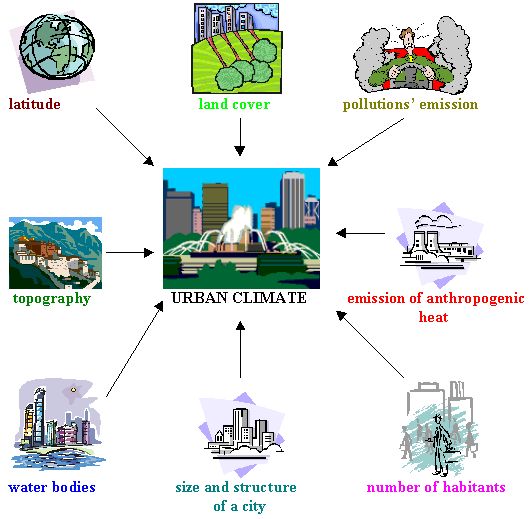 |
|
1. Factors controlling urban climate
|
|
In addition, the three-dimensional geometry of cities tends to trap radiation near the surface and so decreased long-wave radiation loss is observed. This means that a lot of energy is stored in the city during the day-time and gradually radiated out during the night. This slows down the night-time cooling of a city in comparison to non-urban areas. |
|
Another important factor modifying urban climate is air pollution. It changes the composition of the urban atmosphere, decreases transmissivity increasing absorptivity, and therefore reduces the amount of solar radiation reaching the ground surface. In other words, the pollutants in the air take up sunlight and make the air less transparent. Therefore, less solar radiation reaches the ground. Urban air pollution consists of gases and solid particles emitted by industry, transportation, heating systems etc. Usually the city centre is more polluted than the suburbs, but it depends on the location of industry and streets with intensive traffic. During the day-time, the highest air pollution concentrations tend to be observed in the hours with the most intensive traffic. Over the course of a year, the highest concentrations of pollutants tend to occur in winter when lots of harmful air pollution is emitted due to combustion of various kinds of fuel, in order to heat the buildings of a city, and when the atmosphere is the most stable and thus least likely to mix. However, photochemical smog forms in summer when temperatures are highest (more about it in the parts "Ozone smog" and "Air pollution: Negative effects").
|
|
4. Daily changes in air pollution on a typical sunny summer day. Cracow, Poland, 22 Aug., 2003. |
5. Daily changes in air pollution on a typical winter day. Cracow, Poland, 26-27 Dec., 2002.
|
|
|
Another important factor controlling urban climate is anthropogenic heat. It is heat released as a by-product of heating in winter (air conditioning in summer), or from other activities (combustion of fossil fuels, industrial production and transportation). The anthropogenic heat amount depends upon the energy use by individuals, the city`s population density, the amount of industry and the city's location.
|
|
|
|
In a city, evaporation may be significantly reduced as the artificial surfaces do not absorb water like natural ones do. Rather, during the rain, the water quickly runs off into urban sewer systems and the urban surface tends to dry quickly. Thus heat is not used for evaporation (as there is little water to evaporate) but warms the urban atmosphere. However, it is important to recognize that in many cities, or portions of cities, there may be significant amounts of vegetation. The impact of anthropogenic factors on urban climate depends on the city's size and spatial structure, number of habitants, and concentration of industry. Small towns, with relatively low buildings spread among the green areas, without any factories or industrial plants, will tend to modify the climate less than cities with tall buildings.
|
The natural setting where a city is located may have a great impact on the influence of anthropogenic factors on local climate. For example, a city placed in a mountainous basin may experience frequent fog and weak air flow. This causes poor air quality, enhanced by frequent temperature inversions. The concept of air inversion is discussed in the chapter "The vertical structure...". In a city placed in a basin or deep valley, the main reason for the inversion formation is shading the bottom of the landform by the slopes, so that the lower, shaded area stays cooler than the areas placed above, and so does the air near the ground, forming the temperature inversion. Additionally, the cold (and therefore heavier) air from the slopes around the city comes down gravitationally and cumulates in the valley or basin, which strengthens the inversion. The urban climate may be ameliorated by planning the urban structure in such a way as to decrease the negative impact of both anthropogenic and natural factors. For example, through the strategic location of green areas (e.g. parks) and water bodies (e.g. ponds, fountains). Factories should be built with regard to prevailing wind directions, so that the air pollution is taken away by the wind and not brought to the urbanised areas. |
|
|
Related pages: Each surface material has a different albedo. Read more about it in: |
|
About this page:Authors: Sebastian Wypych, Anita Bokwa - Jagiellonian University - Cracow / Poland |

